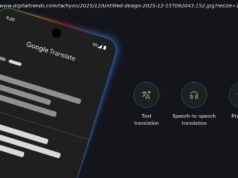At the IFA show earlier this month, I saw many mobile products—phones, tablets, chipsets, and wearable devices. While the new products were not really from the biggest names in the business, they gave me a good opportunity to catch up with the trends in the market.
At the IFA show earlier this month, I saw many mobile products—phones, tablets, chipsets, and wearable devices. While the new products were not really from the biggest names in the business, they gave me a good opportunity to catch up with the trends in the market.
Here are my big mobile takeaways from the show.
There remains room for flagship phones beyond Samsung and Apple. Nothing against the big brands, but I was impressed by both the Sony Xperia XZ3 and the ZTE Axon 9 Pro, which seem quite competitive.
The basic features pretty much meet the top Android phones. The Xperia XZ3 has the Qualcomm Snapdragon 845 processor with 4GB of memory, a 6-inch 2,880-by-1,440 OLED display, and a 3300mAh battery. But like most flagship phones, it aims to differentiate itself by offering superior camera functions, an effort helped along by the fact that Sony makes some of the best image sensors on the market. The Xperia XZ3 has a 19-megapixel “Motion Eye” camera using a 1 / 2.3-inch Exmor RS sensor with a F 2.0 lens and Bionz image processing engine. It offers 5-axis stabilization and can do 960 frames per second slow motion.
The Xperia XZ3 has a “predictive camera” that detects movements and smiles, and captures four images from which users may pick a favorite. It also offers quick access to AI features; for example, if you double-tap on either side of the phone, it predicts the app you want to use next. Notably, if you hold your phone in landscape mode, it will automatically open the camera.
The ZTE Axon 9 Pro (right) also has a Snapdragon 845, but with a 6.2-inch, 2,248-by-1,080 AMOLED screen, a 4000mAh battery, 12-megapixel and 20-megapixel rear cameras, 6GB of RAM, and 128GB of storage. It includes a chip for upscaling content from a wide range of content sources, particularly designed to improve the speed and dynamic range of games.
Meanwhile, Huawei showed its previously announced P20 Pro, which features three different lenses on the rear camera system. The real issue here, however, is that the ZTE and Huawei phones will be difficult to find in the US, as ZTE and Huawei have been banned from government contracts and the US government has dissuaded the carriers from offering their phones. Sony, on the other hand, doesn’t have a deal with any of the major US carriers. Huawei and Sony phones are typically offered unlocked, but for now ZTE isn’t planning on bringing the Axon 9 Pro to the US.
There are many phones we don’t see, or don’t pay attention to. There are all sorts of vendors that make good phones not intended for the American market.
Many of these phones come from companies we don’t see (or don’t see much of) in the US. Mostly, these are midrange Android phones with decent processors and very nice screens, but that don’t match the specs—or the prices—of the higher-end phones. The American market is very much bifurcated between expensive (over $500) phones, mostly sold to customers on carrier plans, and inexpensive (sub-$200) phones, mostly sold to pre-paid or monthly customers. There just isn’t much in-between.
Examples include the Sharp Aquos C10 and D10 (right), which feature Snapdragon 630 processors and 5.5- and 6-inch displays, respectively, and the Aquaris X2 and X2 Pro with Snapdragon 636 or 660 processors and a 5.5-inch display. Of course, all the major Android phone companies—including Huawei, HTC, LG, Motorola, Samsung, Sony, and ZTE—have midrange phones as well. We just don’t pay much attention to them in the US.
One of the most interesting phones in this category was the HiSense A6 (below, left), with a Snapdragon 660 processor, 6GB of RAM and a 6-inch Full HD AMOLED display. It’s a standout as the rear of the phone has a 5.61-inch HD+ e-ink display with a front light. As a result, it can run for a very long time when you are reading books or messages, or running apps that do not require a color display.
Among midrange phones that Americans can buy, one that stands out is the BlackBerry Key2 LE (above, right), a lighter-weight, more consumer-oriented version of what is perhaps the last significant phone to have a physical keyboard. It has a 4.5-inch 1080p screen, a Snapdragon 636,4GB of RAM, and either 32 or 64GB of storage and starts at $399.
Chip wars are alive and well, particularly in mobile. The mobile chip vendors are clearly trying to one-up each other with new process nodes and new “AI” features. At the show, Huawei displayed its Kirin 980, which it claimed as the first 7nm mobile chipset. (Huawei was the first to announce, but Apple followed very quickly with its A12 Bionic, and Apple has now shipped the iPhone XS and XS Max, while the Huawei Mate 20 still seems to be a few weeks away).
Huawei presented a motherboard with the chip running benchmarks that purported to show how much faster it was than Apple’s A11 chip in its iPhone X. I’m always skeptical of such benchmarks until I can use real devices (and there have been particular questions about this one), but more importantly, I’m not sure how relevant it is how many images per second my smartphone can recognize.
Everyone wants to be first with 5G, but no one is really ready. Many booths had 5G demonstrations, but no one is quite ready to show a real 5G phone. T-Mobile’s booth was packed with 5G demos, but no real phone made an appearance. Motorola showed (under glass) its 5G mod for its Moto Z3 phone, but the mod isn’t available yet, and neither is a network for it to run on.
Similarly, ZTE featured both a “5G phone” and a “5G tablet,” but both were under glass.
Samsung showed its Exynos Modem 5100, which it claimed is the first multi-mode modem fully compliant with the 3GPP 5G NR (new radio) Release 15 standard, including mmWave and sub-6GHz bands. And of course, Qualcomm and Intel both touted their progress on 5G as well.
AT&T and Verizon have said they will roll out 5G for fixed wireless in some markets by the end of the year, but I expect it will be next spring before we see the first real 5G phones in the US.
We heard a lot about the new Apple Watch Series 4 and its ability to do ECGs earlier this month, but at IFA, I saw a number of wearables with different and innovative features.






